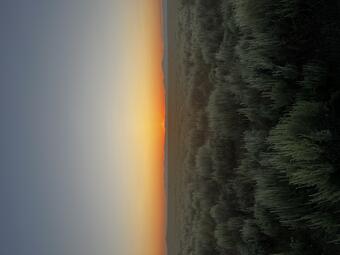Using Vegetation Trends and Fire Risk Simulations to Prioritize Management Interventions on National Park Service Lands in Southern Idaho
City of Rocks National Reserve and Craters of the Moon National Monument and Preserve are lands managed by the National Park Service that contain ecologically valuable stands of sagebrush and unique forest communities that are at risk due to wildfire and invasion by exotic annual grasses. We are working to determine the extent of invasion and to provide park managers with wildfire risk assessments to inform restoration planning and prioritization.

Background
Vegetation in southern Idaho historically consisted of perennial shrubs and grasses with bare soil gaps between them. These gaps naturally control wildfires, keeping them patchy and small. When exotic annual grasses invade sagebrush steppe landscapes, they fill gaps between native plants, which has contributed to recent trends towards larger and more frequent wildfires. Exotic annual grasses also dry out earlier in the summer and are better at colonizing recently burned areas compared to native vegetation, resulting in longer fire seasons and a cycle of more exotic annual grass invasion and more wildfire. Exotic annual grasses also detract from the aesthetic, recreational, geological, historical, and cultural experiences for which these National Park Service sites were first established.
The Fire, Invasion, and Ecology in Sagebrush Steppe (FIRESs) team is working with the National Park Service to determine the extent and abundance of exotic annual grasses at City of Rocks National Reserve and Craters of the Moon National Monument. We are working to identify areas where interventions are most needed and which management techniques could be effective in reducing the spread of exotic annual grasses and fire risk. As of September 2023, we have visited nearly 1,500 sites and collected data on vegetation cover, distance between perennial vegetation, and fuel types and abundance.
Objectives
- Identify areas where exotic annual grasses currently exist within City of Rocks National Reserve and Craters of the Moon National Monument.
- Verify if satellite imagery can accurately detect exotic annual grasses within the parks.
- Assess wildfire risks based on current and projected annual-grass invasions.
- Use these data to assess the best treatment options for protecting the parks and limiting the effects of further invasion.


We are working with the following partners on this project, visit their websites to learn more.
City of Rocks National Reserve and Craters of the Moon National Monument and Preserve are lands managed by the National Park Service that contain ecologically valuable stands of sagebrush and unique forest communities that are at risk due to wildfire and invasion by exotic annual grasses. We are working to determine the extent of invasion and to provide park managers with wildfire risk assessments to inform restoration planning and prioritization.

Background
Vegetation in southern Idaho historically consisted of perennial shrubs and grasses with bare soil gaps between them. These gaps naturally control wildfires, keeping them patchy and small. When exotic annual grasses invade sagebrush steppe landscapes, they fill gaps between native plants, which has contributed to recent trends towards larger and more frequent wildfires. Exotic annual grasses also dry out earlier in the summer and are better at colonizing recently burned areas compared to native vegetation, resulting in longer fire seasons and a cycle of more exotic annual grass invasion and more wildfire. Exotic annual grasses also detract from the aesthetic, recreational, geological, historical, and cultural experiences for which these National Park Service sites were first established.
The Fire, Invasion, and Ecology in Sagebrush Steppe (FIRESs) team is working with the National Park Service to determine the extent and abundance of exotic annual grasses at City of Rocks National Reserve and Craters of the Moon National Monument. We are working to identify areas where interventions are most needed and which management techniques could be effective in reducing the spread of exotic annual grasses and fire risk. As of September 2023, we have visited nearly 1,500 sites and collected data on vegetation cover, distance between perennial vegetation, and fuel types and abundance.
Objectives
- Identify areas where exotic annual grasses currently exist within City of Rocks National Reserve and Craters of the Moon National Monument.
- Verify if satellite imagery can accurately detect exotic annual grasses within the parks.
- Assess wildfire risks based on current and projected annual-grass invasions.
- Use these data to assess the best treatment options for protecting the parks and limiting the effects of further invasion.


We are working with the following partners on this project, visit their websites to learn more.

